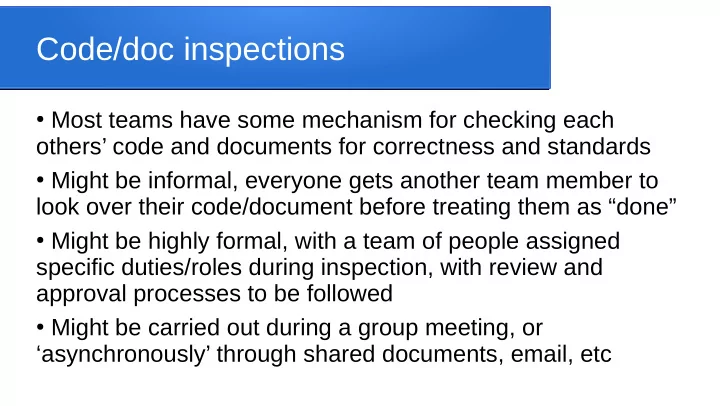

Code/doc inspections ● Most teams have some mechanism for checking each others’ code and documents for correctness and standards ● Might be informal, everyone gets another team member to look over their code/document before treating them as “done” ● Might be highly formal, with a team of people assigned specific duties/roles during inspection, with review and approval processes to be followed ● Might be carried out during a group meeting, or ‘asynchronously’ through shared documents, email, etc
What to inspect ● Really, anything can be inspected – code, documents, data files, images, ... anything that needs to be checked ● Inspection takes time/resources, so might prioritize which items get full inspection, which ones get less formal peer review ● One key issue is deciding how ‘big’ an item to inspect – asking folks to inspect a 10,000 line program isn’t really effective, usually aim for something a person could go through carefully in an hour or so
When to inspect ● When to inspect an item is a bit tricky ● having several people read through something greatly increases chance of catching a defect that the author might not have found for ages, so it’s helpful to do it early ● But inspecting too early means a whole bunch of people all find the ‘easy’ defects the author could clean up easily anyway ● Pre-reqs for inspection might include things like ‘must compile cleanly’, ‘must be in standardized format’, etc
Inspection team ● Common to have 3-5 people involved in an inspection, each gets assigned roles (often multiple roles per person) ● Author: whoever created the item under inspection ● Moderator: acts as coordinator/overseer, makes sure processes are being followed, keeps discussions on topic ● Reader: for inspection meetings, actually reads item line by line, keeping track of where we are so far ● Scribe: formally writes/records down group decisions as we make them ● Inspectors: just lookin for flaws, usually have specific focus areas
Inspection roles ● Having everyone look for everything often results in some areas being overlooked, so usually each inspector given specific priorities, areas, or perspective to use ● Perspectives might be as newbie user, as power user, as support staff, as maintainer, as paying client, etc – inspect the item with an eye to issues impacting those you represent ● Sometimes focus is more techical – you look for pointer problems, you look for interface problems, etc
Recruiting inspectors ● Generally we want a mix of perspectives on the inspection team ● Probably at least one other developer from same team, who has good understanding of the relevant code/docs ● Probably a developer from outside the team, for fresh perspective, independent view ● Possibly someone from testing or support, for yet another distinct perspective
Synchronous inspections ● If inspection is being carried out in a group meeting ● Make sure everyone has materials, knows their role and what the objectives of the inspection are ● Give everyone adequate time to review material prior to meeting time/date ● During meeting, proceed line by line through item, pause for discussion when anyone brings up issue, record group decisions on possible issues ● Follow up after meeting, give everyone copy of inspection summary, see if anyone has corrections or add-ons
Asynchronous inspections ● Much the same idea, but everyone communicating through shared documents, email, chat, etc ● Still need to collate discussion and summarize decisions on each point, moderator might still need to keep discussions from drifting off topic ● Still need to follow up with summary, seek corrections or add-ons
Inspection results ● For items regarded as issues, several possibilities on how to deal with them ● Simple fixes: author supposed to fix them, check in with moderator afterward ● Complex fixes: author needs to check in with some other inspection team members as well, to confirm all is ok ● Major issues: author might have to come back and go through whole inspection again ● Investigative issues: some things might need further investigation before settling on how they should be dealt with
It’s not personal ● Inspections are meant to find defects so they can be fixed ● Finding defects is better than not finding them ● Not meant as a personal criticism of author ● Inspectors should be professional, not make it personal ● Author should be professional, not take things personally ● Moderator needs to help keep tone professional
Recommend
More recommend